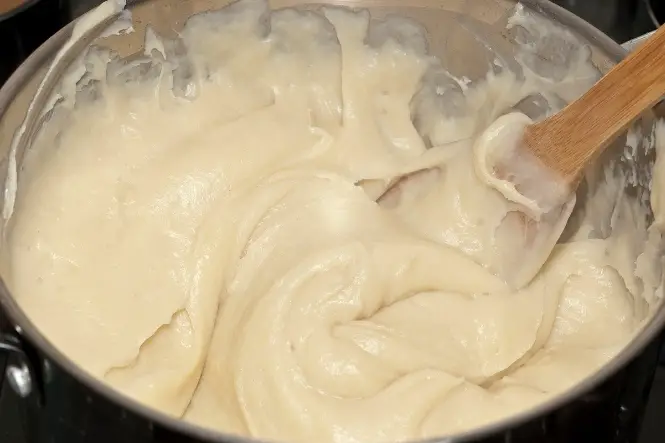Creme Patissiere is a component of recipes such as éclairs, profiteroles, and Boston Cream Pie. Essentially a cold custard, Creme Patissiere is surprisingly simple to make. With fresh vanilla seeds and good milk and eggs, it’s also surprisingly delicious!
About Creme Patissiere
Creme Patissiere is quite similar to English custard, but it’s given a more stable texture by the addition of flour. It is served chilled, and used by French pastry chefs in many different kinds of dessert and pastry. Strawberry tarts are the most famous vehicles for Creme Patissiere; in America, it’s used to fill Boston Cream Pie. Because of its French origins and unfamiliarity, Creme Patissiere can strike terror into the heart of the most experienced British cook! But it’s surprisingly easy to make and use. The only cause for concern is the cooking stage, where curdling can be a risk. But don’t fear – if you can make custard, you can make this. Let’s give it a try!
Making Crème Patissiere
Weigh the cornflour carefully – too much will make the crème stiff and difficult to beat.
You will need:
- 290ml (11fl oz) whole milk
- 1 fresh vanilla pod
- 3 large egg yolks
- 100g (4oz) caster sugar
- 30g (1oz) cornflour
Fill the sink with cold water before you start. This is ready for you to plunge the pan into if the custard starts to curdle.
Prepare the vanilla pod. If you have a choice, pick the fattest, freshest pod to get lots of seeds. Scrape the seeds into a saucepan, the add the pod and pour in the milk.
Put the pan over a low heat. Let it slowly warm up for 10 minutes, until it’s just starting to steam. Cover the pan and put it aside.
Whisk the egg yolks, cornflour and sugar. Use a roomy bowl and (preferably) an electric mixer – it will take 2 minutes to whisk the mixture until it’s pale and light, or 6-10 minutes by hand. (You could use the whites to Make Meringues; add fruit and you’ll have Pavlova!)
Put the bowl on a tea towel. Pick up the pan of warm milk in one hand and continue whisking the eggs with the other hand. Pour a trickle of milk over the yolks and whisk until incorporated (this is done to ‘temper’ or acclimatise the eggs). Then pour in the rest in a slender, steady stream, whisking.
Tip the mixture back into the pan. Set the heat to medium and don’t stop whisking, picking up a wooden spoon to get into the corners. Slowly let the mixture come to the boil and keep it boiling for another two minutes, beating it thoroughly to avoid any burnt bits or lumps. If you don’t stir thoroughly, the eggs could cook in lumps and turn your crème into scrambled eggs!
Take off the heat. The hard part’s over – your crème has thickened and it’s now ready to be cooled. To prevent a skin from forming, you can either rub a little butter over the surface of the crème or cover it with oiled clingfilm, letting the film rest directly on the surface.
Chill thoroughly. Once it’s cooled, your crème is ready to use. Beat it well before using it to pipe into Eclairs or profiteroles, or spreading unctuously between sponge to make a Boston Cream Pie.


